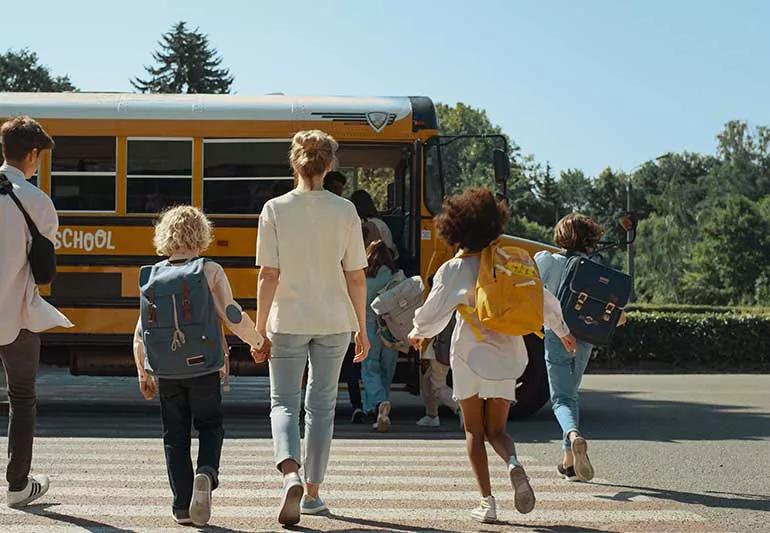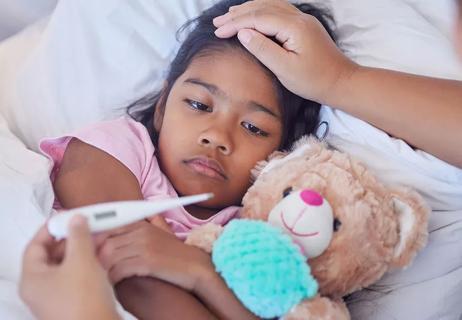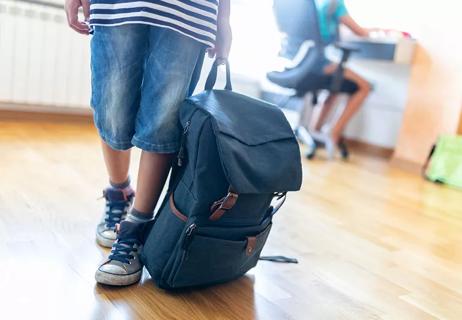Your child’s back-to-school checklist likely includes a lot of things, like buying school supplies, signing permission sheets and packing lunch boxes. Getting sick or hurt probably isn’t on the to-do list, but it can be hard to avoid. After all, schools are petri dishes for all sorts of crud and playgrounds are … well, they’re playgrounds.
Advertisement
Cleveland Clinic is a non-profit academic medical center. Advertising on our site helps support our mission. We do not endorse non-Cleveland Clinic products or services. Policy
Stuffy noses and scraped knees are inevitable. But taking proper safety precautions (and teaching them to your kiddos) can help make the next school year as healthy as it is exciting. Pediatrician Adam Keating, MD, shares his back-to-school safety tips to for everything from bikes and busses to backpacks and the buddy system.
Transportation
Dr. Keating explains that no matter how your child gets to and from school, you want to make sure they bone up on these four safety basics:
- Never approach a stopped car. If somebody asks you for directions or tries to talk to you, keep your distance from the vehicle. If the person makes you uncomfortable for any reason, or gets out of the car, run as fast as you can to the nearest trusted adult.
- Use the buddy system. Going to school shouldn’t be something your child does alone. Walking in groups is much safer from both a health and a security standpoint.
- Have a pick-up password. There may be times when your child needs to be picked up from school — like if they need to go home sick, or they have a particularly bulky school project to wrangle. Make it easy for your kid to assess who is and isn’t OK to leave with by deciding on a “code word.”
- Stay alert. In a world of smartphones, handheld gaming systems and earbuds, it’s easy to tune out on the way to school. But it’s important to be aware of your surroundings. That means eyes open, ears open and hands free.
If your child is responsible for getting themselves to and from school, it’s important that they have a way of communicating with you (and emergency services) if something happens. Cell phones are the most common way to keep tabs on a tiny (or not-so-tiny) traveler. And remember: If your child uses a buddy system to get to school, be sure you both have the numbers of their friends’ parents saved.
If your kiddo can’t use a cell phone, putting a GPS tracker on their backpack (or a kid-friendly smartwatch on their wrist) can help you know where they are on their route to and from school. Some of the GPS trackers even have virtual fence capabilities, so you get alerted when they arrive home.
School bus safety
According to the National Highway Traffic Safety Administration (NHTSA), children are most at risk when getting on and off the school bus. If your child is riding the bus for the first time — or if they need a refresher — these are the most important safety tips to remember:
- The driver can’t see directly in front of/behind the bus. It’s important to always give a school bus a wide berth because big buses = big blind spots. Kids should never walk behind or in front of a bus without first making eye contact with the driver. Dr. Keating adds that it’s especially important you don’t bend over (like you would to ties your shoes) in front of or behind a bus. If you drop something, alert the driver first and then retrieve the item.
- Stay back from the curb. The first time you walk your wee one to the bus stop, make them take five to 10 big steps back from the curb. Tell them not to move closer to the bus until it’s come to a complete stop and the doors are open.
- Don’t run or play at the bus stop. Or, rather, play games that are stationary, like rock paper scissors, 20 questions or I spy.
Bicycle safety
Biking to school isn’t just fun, it’s also great exercise! But Dr. Keating reminds us that it can also be dangerous if you and your child don’t take the proper precautions.
- Choose a safe route to and from school. Sometimes, the fastest way to get from point A to point B isn’t the safest. Review the different possible routes with your child and make sure they stick with the one you choose (no shortcuts!). The ideal bike route will have few or no intersections, light traffic and minimal distractions.
- Practice makes perfect. Knowing the rules and implementing them are two different things. If you can, do some practice runs before school starts. It will help your child feel more comfortable crossing intersections, riding in a straight line and using hand signals — and it will help you be sure that they’re ready to ride to school unsupervised.
- Inspect the bike regularly. If your young one’s bike isn’t safe, it doesn’t really matter how many precautions you take. Make a point of regularly checking the tire pressure, brakes, gear shift and chains — and teach your child to do the same. And if your kiddo’s suddenly sprouting up, check that they’re riding an appropriately sized bike. A bike that’s too small can cause injuries.
- Dress for success. When it comes time to do your back-to-school bike shopping, encourage your child to wear bright colors and consider adding a role of reflective tape to your shopping cart. Be very clear that wearing a helmet is non-negotiable. Dr. Keating says you should also check periodically to be sure the helmet still fits correctly. That means measuring the circumference of your child’s head and checking to ensure the helmet is (1) sitting level and (2) sitting low on their forehead. You should also check that straps are tight enough that no more than two fingers can fit underneath — and that the straps form a “V” shape around their ear.
Pedestrian safety
If you’re lucky enough to live within walking distance of your children’s school, that’s great! Here are Dr. Keatings’s tips for making sure the trip to school is as safe as it is invigorating:
- Don’t hitchhike. Let’s face it: Sometimes, walking to and from school stinks. Maybe it’s raining, or that scrape on your kid’s knee is worse than they realized. Maybe they’re just running really late. Drill into them that it’s still never safe to accept a ride from somebody you don’t know.
- Agree on the route ahead of time. When it comes to walking to school, it’s important that your kid takes a path that’s busy, but not too busy — and that you know exactly what that path is. Walking in a secluded area or taking short cuts can make it hard to find a child in an emergency, but you also don’t want them having to cross too many intersections or negotiate too much traffic.
- Make a contingency plan. Make sure they know how to get home in inclement weather, emergencies or other events that might prevent their walking home.
- Locate trusted adults. Introduce your child to any crossing guards, parent volunteers, police officers or other adults they’ll routinely encounter on their walk to school.
Safe driving
For teenagers of a certain age, there’s little more exciting than the prospect of driving themselves to school. Dr. Keating suggests you and your freshly minted motorist put these items on your to-do list:
- Know the graduated driver’s license (GDL) laws in your state. Different states have different rules about everything — from the number of passengers allowed in the car and nighttime driving to cell phone use. Make sure you and your teen know what’s allowed when.
- Establish a “driving contract.” Sit down with your teen and spell out your expectations of them as new motorists. Are they allowed to have passengers? How late can they drive? Do they have to call you when they get to school or get home? Do they have to stay off the highways? Do they need to pay for gas and insurance? What consequences will they face if they break a rule? It’s helpful for both you and your child to be on the same page at the outset.
- Review the basics. Did you know that seatbelt use is lowest among teen drivers? While it may feel a little silly, it’s important to talk to your kid about the basic rules of the road. Wear your seatbelt. Obey traffic signs (and know what they mean). Don’t drink and drive. Don’t use a cellphone or text while driving. It’s being a responsible adult 101, but guess what? They aren’t adults yet!
Once you’ve got those fundamentals down, Dr. Keating suggests keeping these safety tips in mind:
- Be a good role model. If you don’t want your child blasting music at top volume when they’re driving, don’t do it yourself! Modeling safe and responsible driving behavior can have a bigger impact than you might realize.
- Prevent drowsy driving. High school isn’t known for being a particularly restful time in a young person’s life. That’s a problem because driving while sleep deprived can be just as dangerous as driving under the influence of alcohol or drugs. Encourage your child to get plenty of sleep and urge them never to get behind the wheel if they’re too tired … even if waiting means being a couple minutes late getting home.
- Make space for mistakes and inconveniences. Every parent hopes their teenager will make good decisions when they’re unsupervised, but it’s not always going to happen. Talk with them about what to do if they’re in a situation that isn’t safe. You don’t want your child speeding home or driving under the influence to avoid getting in trouble.
- Allow them to opt out. It’s important to encourage your child to speak up if something about driving has them worried. Maybe they just aren’t comfortable driving in snow yet, or driving their sibling home, or getting on the highway. Maybe they need a bit more practice time before they transition from a learner’s permit to a provisional license. Encourage your teen to problem-solve with you.
Health precautions
The COVID-19 pandemic has taught us all how important being able to go to attend school is for children’s mental health, growth and development. It’s also taught us that we all have a responsibility to protect ourselves — and the people around us — from infectious disease.
A completely illness-free school year probably isn’t in the cards, but Dr. Keating says doing these four things can help keep bugs at bay:
1. Make an appointment with their pediatrician
With all the hustle and bustle of a new school year, it can be easy to overlook preventive care. But it’s important for kids to attend those appointments. Without them, they can fall behind on the schedule of childhood vaccinations. Regular pediatrician checkups are also vital to maintaining their health.
If your wee one’s already a bit behind, it’s not the end of the world. Luckily, it’s never too late to get caught up.
“If you’ve fallen behind on well-child preventive care, make an appointment with your child’s medical provider,” says Dr. Keating. “There are more reasons than just immunizations to visit your pediatrician every year. We want to look at a child’s growth and development, do screenings, look at mental health and social situations and offer comprehensive advice.”
2. Stay up to date on vaccinations
Your child probably got a lot of the vaccines they needed by the age of 2. But some shots require boosters and others — like the HPV vaccine — aren’t given to children until they’re older. These are the jabs children in the US need to get as part of their complete schedule of vaccines.
Vaccines for Ages 4-6
- DTaP (diphtheria, tetanus and acellular pertussis).
- IPV (inactivated poliovirus).
- MMR (measles, mumps and rubella).
Vaccines for Ages 9-12
- HPV (human papillomavirus).
Vaccines for Ages 11-12
- Tdap booster (diphtheria, tetanus and acellular pertussis).
- Meningococcal.
Vaccines for Age 16
There are a few things to keep in mind when reviewing the schedule:
- Some of these vaccines are given multiple times or are comprised of a series of shots administered over an extended period.
- Certain schools or local governments may require additional vaccines.
- Your child may require additional vaccines as a result of a medical condition. For example, a child with sickle cell disease will likely be urged to get additional pneumococcal conjugate vaccines (PCV) after age 2.
Dr. Keating also urges children and parents alike to get the flu (influenza) vaccine every year.
COVID-19 vaccination
While it’s the last thing we want to think about, it’s always possible that a new COVID-19 wave or variant could disrupt the school year. None of us want that. That’s why it’s equally important to take preventive measures now.
The COVID-19 vaccine is currently available and changing to meet the needs of the public as the virus changes. The COVID-19 vaccine booster schedule has changed recently. Check with your healthcare provider if you’re due or look at the U.S. Centers for Disease Control and Prevention (CDC)’s up-to-date vaccine recommendations.
“In the general population, kids do tend to be at lower risk for complications of COVID compared to adults, particularly older adults,” notes Dr. Keating. “But that doesn’t mean zero risk. And the vaccines really are safe and effective.” Kids ages 6 months and up are eligible for covid vaccine.
What if your kiddo recently had COVID-19? How does that change their vaccination schedule?
“Generally, if someone has an acute infection with COVID, it’s probably reasonable to have some time spaced between their booster and their acute infection,” he adds. “And it’s worth talking with their doctor about what that optimal interval is.”
3. Practice good hygiene
For kids heading back to school, there are a few simple hygiene rules they can follow to stay healthy.
“We’ve all learned how important basic hand washing is for preventing illness, as well as not touching your eyes, nose and mouth as much as you can,” says Dr. Keating. “These are great ways to transmit pretty much any respiratory virus. Keeping distance from those that are coughing and sneezing certainly decreases the risk as well.”
If your kidis the one coughing or sneezing, they can help keep their classmates safe by using the crook of their elbow, not their hands, to cover their mouth. It’s also a good idea to consider masking if your child is returning to school after any respiratory infection, not just COVID-19.
It’s also important to clean surfaces regularly and avoid sharing food and drink to avoid getting sick with conditions like norovirus, pink eye (conjunctivitis) and respiratory syncytial virus (RSV).
4. Keep kids home when they’re sick
No matter how cautious everybody is, schools are infectious disease incubators. So, when your child inevitably comes down with a contagious condition like the common cold, or hand, foot and mouth disease (HFMD), it’s important to keep them home until they’re better.
Dr. Keating reminds us that you should never send a child with a fever to school, even if all of their other symptoms have subsided. A fever is a sign that they’re still ill and potentially shedding germs.
In the case of bacterial infections like strep throat, it’s also important to keep your kiddo home for the first 12 hours they’re on antibiotics.
Playgrounds and sports
Between recess, gym class and team sports, it’s tough to get through an entire school year without a boo-boo or two-two.
Dr. Keating recommends teaching your wee ones the following rules to keep play time as safe as it is fun:
- Remove accessories. Scarves, necklaces and clothing with drawstrings are great in the classroom. (And bike helmets are awesome on bikes.) But on the playground, these accessories can cause injuries.
- Follow playground or facility rules. For example, if a piece of playground equipment is designed for kids 5 and under, it’s important that the 12-year-old stays off it.
- Check equipment before you play on it. Your kid doesn’t need to be Sherlock Holmes or anything — but taking a moment to “investigate” before playing can be super helpful. Is the jungle gym wet? Is the merry-go-round burning hot? Or freezing cold? If so, maybe play on something else.
- Play on equipment as directed. Just because it’s possible to hang upside down on the monkey bars doesn’t mean it’s a good idea. And baseballs are great for playing baseball — but that doesn’t mean they’re good for an impromptu game of dodgeball.
- Wait your turn. Don’t slide down the slide if somebody else is still on it, or push somebody else off the balance beam, or attempt to wrap four tiny hands around a single zipline.
- Be aware of your surroundings. We’ve probably all seen it happen before. A kid walks directly in front of a swing set that’s in use, only to get clobbered. An ultimate-frisbee champion in the making tosses their frisbee around in the middle of a crowded playground and clocks an unsuspecting classmate. It’s going to happen from time to time, but teaching kids to pay attention to what’s happening around them can help prevent these kinds of injuries.
- Don’t forget to drink plenty of water. Whether you’re playing a sport or just plain playing, all that physical activity will raise your body temperature. Your body produces sweat to help cool you down, but if you’re not replenishing those lost fluids, you could end up dehydrated before you know it. Be sure to get a drink before and after recess or practice and take a break (and a swig of water) if you aren’t feeling well.
Backpacks and school supplies
The dreaded back-to-school shopping list seems to get longer every single year. But when it comes to health and safety, the supply list is mercifully short! Dr. Keating recommends your child have the following on hand when they hit the hallways this fall:
- A mask or face covering. Tell your little one to wear it if they feel a bug coming on.
- Hand sanitizer. The bottles that clip to their backpacks are great for avoiding messy spills.
- Tissues. Better in a tissue than on their sleeve … or their best friend’s sleeve!
- Reusable water bottle. Most schools have water fountains, but it’s always a good idea to have some water on hand.
If you’re feeling generous, consider donating disinfecting wipes, hand sanitizer and boxes of tissues to your student’s classroom. Trust us: If their teacher doesn’t need them, somebody else will!
Backpacks
For some kids, choosing the right backpack is a big deal. They want to make a fashion statement (who doesn’t?), but safety should always be priority No. 1. Dr. Keating’s advice for picking the best backpack is:
- Choose a backpack that’s age appropriate. In practical terms, you’re looking for a backpack that sits 2 inches above their hips.
- They may be stylish, but it’s best to avoid single strap or crossbody bags.
- Choose backpacks with broad, padded base straps.
- Try to find a backpack with multiple compartments. That will make it easier to evenly distribute the weight.
- If the best backpack isn’t the “coolest” backpack, customize it with patches, keychains and other fun decorations.
And it’s not just about choosing the right backpack, it’s also about what you pack!
According to the American Academy of Pediatrics, a child’s backpack should weigh no more than 15% of their weight. Carrying a backpack that’s too heavy can cause back, neck and shoulder pain and even affect your little bookworm’s posture.
Emergency preparedness
Nobody ever wants to think about an emergency happening during the school day, but preparation is the best prevention. Here are some things you can do to put your mind at ease:
- The CDC has a free printable backpack emergency card kit. It includes a card to put in your kiddos backpack and a guardian card for you. This is an especially great idea if your child has any allergies, special needs or medical conditions that a teacher or doctor should know about.
- If your child has a health condition that requires them to take prescription medications during school hours — or a condition, like a severe allergy, that could require emergency medication — have a conversation with your pediatrician. Some schools require dedicated prescriptions, so it’s good to have the conversation early.
- If you have a child with a serious condition like epilepsy or diabetes — or your child isn’t always able to communicate — consider purchasing a medical alert necklace or bracelet. These days, you can get ID jewelry for kids of all ages, with lots of fun (or fancy) designs. Some are even customized to the specific condition!
The bottom line
Your kid may not be back in school yet, but there are still plenty of lessons they can learn to ensure they stay happy, healthy and safe this year. From preventive healthcare and backpack selection to bus stop safety and playground rules, every little bit helps!











